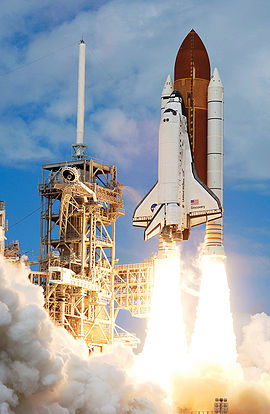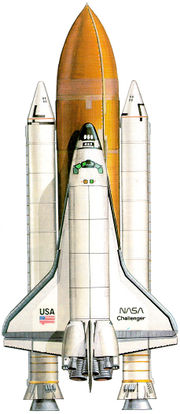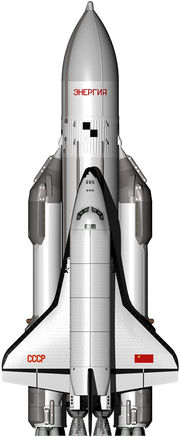Space Shuttle Endeavour
| Endeavour OV-105 |
|
|---|---|
 Space Shuttle Endeavour on launch pad 39A prior to mission STS-127, July 15, 2009. |
|
| OV designation | OV-105 |
| Country | United States |
| Contract award | July 31, 1987 |
| Named after | HMS Endeavour |
| Status | Active |
| First flight | STS-49 May 7, 1992 - May 16, 1992 |
| Last flight | STS-130 February 8-21, 2010 |
| Number of missions | 24 |
| Crews | 148 |
| Time spent in space | 280 days, 9 hours, 39 minutes, 44 seconds |
| Number of orbits | 3,964 |
| Distance travelled | 166,003,247 km (103,149,636 mi) |
| Satellites deployed | 3 |
| Mir dockings | 1 |
| ISS dockings | 10 |

Space Shuttle Endeavour (Orbiter Vehicle Designation: OV-105) is one of three currently operational orbiters in the Space Shuttle fleet of NASA, the space agency of the United States.[1] (The other two are Discovery and Atlantis.) Endeavour is the fifth and final spaceworthy NASA space shuttle to be built, constructed as a replacement for Challenger. Endeavour first flew in May 1992 on mission STS-49 and is scheduled for decommissioning in 2010.[2] Before its decommissioning, NASA expects to use Endeavour for the STS-134 mission, and the last shuttle to fly for the last mission of the Space Shuttle Program.[3]
Contents |
History

The United States Congress authorized the construction of Endeavour in 1987 to replace Challenger, which was lost in an accident in 1986. Structural spares from the construction of Discovery and Atlantis, two of the three remaining operating shuttles at the time, were used in its assembly. The decision to build Endeavour was favored over refitting Enterprise on cost grounds.
The orbiter is named after the British HMS Endeavour, the ship which took Captain James Cook on his first voyage of discovery (1768-1771).[4] This is why the name is spelled in the British English manner, rather than the American English ("Endeavor"). This has caused confusion, most notably when NASA themselves misspelled a sign on the launch pad in 2007.[5] The name also honored Endeavour, the Command Module of Apollo 15.
Endeavour was named through a national competition involving students in elementary and secondary schools. Entries included an essay about the name, the story behind it and why it was appropriate for a NASA shuttle, and the project that supported the name. Endeavour was the most popular entry, accounting for almost one-third of the state-level winners. The national winners were Senatobia Middle School in Senatobia, Mississippi, in the elementary division and Tallulah Falls School in Tallulah Falls, Georgia, in the upper school division. They were honored at several ceremonies in Washington, D.C., including a White House ceremony where then-President George H.W. Bush presented awards to each school.[6]
Endeavour was delivered by Rockwell International in May 1991 and first launched a year later, in May 1992, on STS-49. Rockwell International claimed that it had made no profit on Space Shuttle Endeavour, despite construction costing US$2.2 billion. On its first mission, it captured and redeployed the stranded INTELSAT VI communications satellite.
In 1993, it made the first service mission to the Hubble Space Telescope. Endeavour was withdrawn from service for eight months in 1997 for a retrofit, including installation of a new airlock. In December 1998, it delivered the Unity Module to the International Space Station.
Endeavour completed its latest Orbiter Major Modification period, which began in December 2003, and ended on October 6, 2005. During this time, the Orbiter received major hardware upgrades, including a new, multi-functional, electronic display system, often referred to as glass cockpit, and an advanced GPS receiver, along with safety upgrades recommended by the Columbia Accident Investigation Board (CAIB) for Shuttle return to flight after the disintegration of sister-ship Columbia during re-entry on February 1, 2003.
The STS-118 mission, the first for Endeavour following a lengthy refit, included astronaut Barbara Morgan, formerly assigned to the Educator Astronaut program, but now a full member of the Astronaut Corps, as part of the crew. Morgan was the backup for Christa McAuliffe on the ill-fated STS-51-L mission.
Upgrades and features
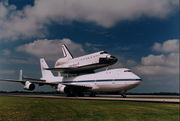
As it was constructed later, Endeavour was built with new hardware designed to improve and expand orbiter capabilities. Most of this equipment was later incorporated into the other three orbiters during out-of-service major inspection and modification programs. Endeavour’s upgrades include:
- A 40-foot (12 m) diameter drag chute that is expected to reduce the orbiter's rollout distance by 1,000 to 2,000 feet (300 to 610 m).
- The plumbing and electrical connections needed for Extended Duration Orbiter (EDO) modifications to allow up to 28-day missions (although a 28-day mission has never yet been attempted; the current record is 17 days, which was set by Columbia).
- Updated avionics systems that include advanced general purpose computers, improved inertial measurement units and tactical air navigation systems, enhanced master events controllers and multiplexer-demultiplexers, a solid-state star tracker and improved nose wheel steering mechanisms.
- An improved version of the Auxiliary Power Units (APUs) that provide power to operate the Shuttle's hydraulic systems.
Modifications resulting from a 2005-2006 refit of Endeavour include:
- The Station-to-Shuttle Power Transfer System (SSPTS), which converts 8 kilowatts of DC power from the ISS main voltage of 120VDC to the orbiter bus voltage of 28VDC. This upgrade will allow Endeavour to remain on-orbit while docked at ISS for an additional 3- to 4-day duration. The corresponding power equipment was added to the ISS during the STS-116 station assembly mission, and Endeavour flew with SSPTS capability during STS-118.[7][8][9]
Planned decommissioning


Endeavour was originally scheduled to be decommissioned in 2010 after 18 years of service, but on July 1, 2010, NASA released a statement saying the shuttle Endeavour mission was rescheduled for February 26, 2011, instead of late November, 2010.[10]
"The target dates were adjusted because critical payload hardware for STS-133 will not be ready in time to support the previously planned September 16 launch," NASA said in a statement. With the Discovery launch moving to November, the Endeavour mission "cannot fly as planned, so the next available launch window is in February 2011," NASA said, adding that the launch dates are subject to change.
Endeavour's final flight was originally scheduled for July 29, 2010, but was postponed. Shuttle Discovery was going to be the last of the Space Shuttle program, on the STS-133 mission to the International Space Station, which will carry the next to final components in the ISS assembly sequence, the EXPRESS Logistics Carrier ELC5 and ELC1, to orbit. However, in 2008 one more mission (STS-134) was funded, and so Endeavour is now slated to be the final Orbiter to fly.
NASA has offered two of the three remaining orbiters for museum donation once they are withdrawn from service. March Field Air Museum in Riverside, California has submitted a proposal to NASA for the display of an orbiter, and has stated a preference to receive Endeavour, due to the local connection of astronaut Tracy Caldwell, who grew up in Beaumont and flew on Endeavour during mission STS-118.[11]
Flights
| # | Launch date | Designation | Launch pad | Landing location | Notes |
|---|---|---|---|---|---|
| 1 | 1992-05-07 | STS-49 | 39-B | Edwards Air Force Base | First flight of Endeavour: Capture and redeploy Intelsat VI. First three-man EVA, longest US EVA since Apollo 17. |
| 2 | 1992-09-12 | STS-47 | 39-B | Kennedy Space Center | Spacelab mission J |
| 3 | 1993-01-13 | STS-54 | 39-B | Kennedy | Deploy TDRS-F |
| 4 | 1993-06-21 | STS-57 | 39-B | Kennedy | Spacelab experiments. Retrieve European Retrievable Carrier |
| 5 | 1993-12-02 | STS-61 | 39-B | Kennedy | First Hubble Space Telescope service mission (HSM-1) |
| 6 | 1994-04-09 | STS-59 | 39-A | Edwards | Space Radar Laboratory experiments |
| 7 | 1994-09-30 | STS-68 | 39-A | Edwards | Space Radar Laboratory experiments |
| 8 | 1995-03-02 | STS-67 | 39-A | Edwards | Spacelab Astro-2 experiments |
| 9 | 1995-09-07 | STS-69 | 39-A | Kennedy | Wake Shield Facility and other experiments |
| 10 | 1996-01-11 | STS-72 | 39-B | Kennedy | Retrieve Japanese Space Flyer Unit |
| 11 | 1996-05-19 | STS-77 | 39-B | Kennedy | Spacelab experiments |
| 12 | 1998-01-22 | STS-89 | 39-A | Kennedy | Rendezvous with Mir space station and astronaut exchange |
| 13 | 1998-12-04 | STS-88 | 39-A | Kennedy | International Space Station assembly mission (assembled the Unity Module (Node 1), first American component of the ISS) |
| 14 | 2000-02-11 | STS-99 | 39-A | Kennedy | Shuttle Radar Topography Mission experiments |
| 15 | 2000-11-30 | STS-97 | 39-B | Kennedy | International Space Station assembly mission (P6 truss segment) |
| 16 | 2001-04-19 | STS-100 | 39-A | Edwards | International Space Station assembly mission (Canadarm2 robotic arm and hand) |
| 17 | 2001-12-05 | STS-108 | 39-B | Kennedy | International Space Station rendezvous and astronaut exchange (Expedition 3/Expedition 4) |
| 18 | 2002-06-05 | STS-111 | 39-A | Edwards | International Space Station rendezvous and astronaut exchange (Expedition 4/Expedition 5) |
| 19 | 2002-11-23 | STS-113 | 39-A | Kennedy | International Space Station assembly mission and astronaut exchange/final successful shuttle flight before the Columbia disaster (Expedition 5/6 exchange; P1 truss segment assembly) |
| 20 | 2007-08-08 | STS-118 | 39-A | Kennedy | Four spacewalks conducted.[12] Installation of the International Space Station S5 Truss, of the Integrated Truss Structure. Carried a SPACEHAB module carrying 5,000 pounds of supplies and equipment to the International Space Station. Crew included the Educator Astronaut Barbara Morgan. Thermal tiles protecting the underside of the vehicle were damaged during launch. NASA decided not to fix this damage in-flight as it was not believed to be serious enough to result in loss of vehicle or crew. The craft landed a day early due to the possibility that Hurricane Dean would force Mission Control to evacuate. |
| 21 | 2008-03-11 | STS-123 | 39-A | Kennedy | International Space Station assembly mission which delivered the first element of Japan's Kibo module along with the Canadian Special Purpose Dexterous Manipulator robotic arm, and the Spacelab Pallet-Deployable 1. |
| 22 | 2008-11-14 | STS-126 | 39-A | Edwards[13] | International Space Station assembly mission that brought equipment and supplies in the Multi-Purpose Logistics Module Leonardo, and Expedition 18 crew rotation, Sandra Magnus replaced Gregory Chamitoff. Endeavour was the only orbiter to land on the temporary Runway 4 at Edwards AFB, as the refurbished main runway will be operational from STS-119 onwards.[14] |
| 23 | 2009-07-15[15] | STS-127 | 39-A | Kennedy | International Space Station assembly mission which delivered the last two elements of Japan's Kibo Module along with the Spacelab Pallet-Deployable 2, and an Integrated Cargo Carrier-Vertical Light Deployable.[16] |
| 24 | 2010-02-08 | STS-130 | 39-A | Kennedy | International Space Station assembly mission which delivered the Node 3 and the Cupola observatory to the station. This brought the ISS to 98 percent completion. |
| 25 | 26 February, 2011* | STS-134 | 39-A | Kennedy | International Space Station assembly mission which will deliver the Alpha Magnetic Spectrometer and the ELC-3 to the space station. Once this is complete, the space shuttle program will have sent its last flight to outer space on the Space Shuttle. This will be the final mission of Endeavour and the last mission of the Space Shuttle Program. |
‡ Longest shuttle mission for Endeavour
+ Targeted date as mission has yet to launch
* No Earlier Than (Tentative)
Mission insignias
| Mission insignia for Endeavour flights | |||||||
|---|---|---|---|---|---|---|---|
 |
 |
 |
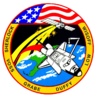 |
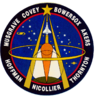 |
 |
 |
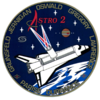 |
|
|
|
|
|
|
|
|
|
 |
 |
 |
 |
 |
 |
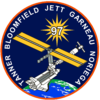 |
 |
|
|
|
|
|
|
|
|
|
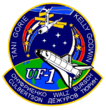 |
 |
 |
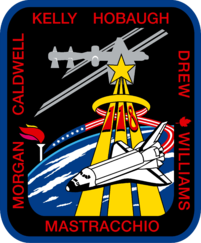 |
 |
 |
 |
 |
|
|
|
|
|
|
|
|
|
 |
|||||||
|
|
|||||||
See also
- List of human spaceflights
- List of Space Shuttle crews
- List of space shuttle missions
- Timeline of Space Shuttle missions
- List of human spaceflights chronologically
- Thiokol
References
- ↑ "Space Shuttle Overview: Endeavour (OV-105)". NASA. http://www.nasa.gov/centers/kennedy/shuttleoperations/orbiters/endeavour-info.html.
- ↑ "STS-49". NASA KSC. http://science.ksc.nasa.gov/shuttle/missions/sts-49/mission-sts-49.html.
- ↑ "Consolidated Launch Manifest". NASA. http://www.nasa.gov/mission_pages/station/structure/iss_manifest.html.
- ↑ http://www-pao.ksc.nasa.gov/shuttle/resources/orbiters/Endeavour.html
- ↑ "Shuttle's Name Misspelled On NASA Launch Pad Sign". WKMG-TV. http://www.local6.com/technology/13675075/detail.html. Retrieved 2007-07-14.
- ↑ "The Naming Of The Space Shuttle Endeavour". NASA. http://www.nasa.gov/audience/foreducators/stseducation/stories/F_The_Naming_of_Space_Shuttle_Endeavour.html.
- ↑ "Vehicle Upgrades: Station-Shuttle Power Transfer System (SSPTS)". Boeing: Integrated Defense Systems. http://www.boeing.com/defense-space/space/returntoflight/vehicleupgrades/sspts.html.
- ↑ "NASA Presolicitation Notice: Station-Shuttle Power Transfer System (SSPTS)". NASA. http://www.spaceref.com/news/viewsr.html?pid=10776.
- ↑ "NASA's Space Shuttle Processing Status Report: S05-034". NASA. 2 December 2005. http://www.nasa.gov/home/hqnews/2005/dec/HQ_S05034_shuttle_status.html.
- ↑ http://www.nasa.gov/home/hqnews/2010/jul/HQ_10-157_STS_Launch_Dates.html
- ↑ March Field Air Museum hopes to land a space shuttle - The Press Enterprise, 28/03/09
- ↑ "Space Shuttle Mission STS-122". Nasa.gov. 2009-05-24. http://www.nasa.gov/mission_pages/shuttle/main/index.html. Retrieved 2009-07-17.
- ↑ NASA (November 30, 2008). "NASA RSS archive". NASA. http://www.nasa.gov/mission_pages/shuttle/main/rss_feed_above_snip_collection_archive_1.html. Retrieved November 30 2008.
- ↑ Bergin, Chris (November 30, 2008). "Endeavour lands at Edwards to conclude STS-126". NASASpaceflight.com. http://www.nasaspaceflight.com/2008/11/endeavour-lands-at-edwards-to-conclude-sts-126/. Retrieved November 30, 2008.
- ↑ "NASA - NASA's Shuttle and Rocket Launch Schedule". Nasa.gov. http://www.nasa.gov/missions/highlights/schedule.html. Retrieved 2009-07-17.
- ↑ "STS-127 MCC Status Report #32". NASA. July 31, 2009. http://www.nasa.gov/mission_pages/shuttle/shuttlemissions/sts127/news/STS-127-32.html. Retrieved August 01, 2009.
External links
- Mission Summary Archive
- Where is Space Shuttle Endeavour (STS-130) right now?
- Shuttle Orbiter Endeavour (OV-105)
- 04/16/07: Consolidated Launch Manifest: Space Shuttle Flights and ISS Assembly Sequence.
- Space Shuttle Endeavour Pictures at the ISS
|
||||||||||||||||||||||||||||||||||||||||||||||||||||||||||||||||||||||||||||||||||||||||||||||||
